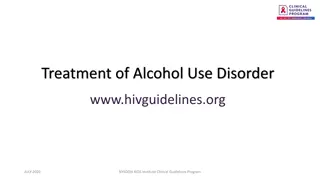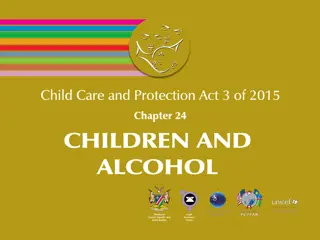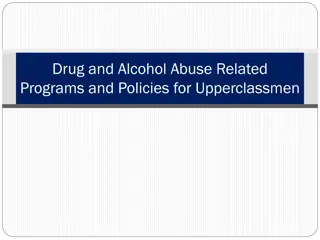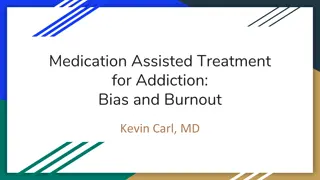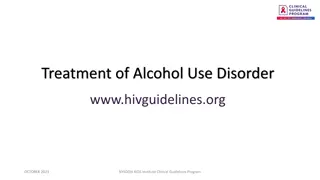Factors Influencing Dropout in Outpatient Alcohol Addiction Treatment
This study investigates the reasons behind patient dropouts in outpatient alcohol addiction treatment programs. It focuses on various factors such as socio-demographic characteristics, alcohol- and treatment-related variables, health-related quality of life, and cognitive impairments. The research involved 150 adult patients in France, with a significant proportion being men employed in factories and experiencing alcohol issues for the first time seeking formal care. Questionnaires were administered at baseline and a 6-month follow-up to understand the differences between patients who completed treatment and those who dropped out.
Download Presentation

Please find below an Image/Link to download the presentation.
The content on the website is provided AS IS for your information and personal use only. It may not be sold, licensed, or shared on other websites without obtaining consent from the author.If you encounter any issues during the download, it is possible that the publisher has removed the file from their server.
You are allowed to download the files provided on this website for personal or commercial use, subject to the condition that they are used lawfully. All files are the property of their respective owners.
The content on the website is provided AS IS for your information and personal use only. It may not be sold, licensed, or shared on other websites without obtaining consent from the author.
E N D
Presentation Transcript
OUTPATIENT ADDICTION TREATMENT FOR ALCOHOL USE DISORDER: What makes patients who dropped out different from those who did not? Vincent Wagner, Didier Acier, and Jean-Eric Dietlin Lisbon, October 24-26, 2017 www.univ-nantes.fr www.psychologie.univ-nantes.fr/
CONFLICT OF INTEREST I have no conflict of interest to disclose 1 [What makes patients who dropped out different from those who did not?]
BACKGROUND A major public health concern Only a few people are actually looking for help Up to 50% dropouts during care (Deane et al., 2012; McHugh et al., 2013) Alcohol misuse in France Real issue for care and change processes Many variables involved Contradictory research (Brorson et al., 2013) Dropouts from alcohol- specialized treatment 2 [What makes patients who dropped out different from those who did not?]
AIM OF THE STUDY To explore dropouts from alcohol-specialized treatment Based on the literature and discussion with local stakeholders, we studied various variables : socio-demographic characteristics alcohol- and treatment-related variables health-related quality of life time perspectives cognitive impairments 3 [What makes patients who dropped out different from those who did not?]
SAMPLE 150 patients Adults (M 45 years old) first visiting an outpatient center in France for a problematic alcohol use 74% men, 67% employees or factory workers Exclusive alcohol use (79%) First experience of formal care for alcohol issue (65%) 4 [What makes patients who dropped out different from those who did not?]
MATERIAL Clinical summary sheet Sociodemographic, and treatment-related data alcohol- AUDIT (Babor et al., 2001) SOCRATES 1996) AAAQ (McEvoy et al., 2004) MOCA (Nasreddine et al., 2005) MOS-SF-36 (Lepl ge et al., 2001) ZTPI (Zimbardo & Boyd, 1999) (Miller & Tonigan, Several questionnaires 5 [What makes patients who dropped out different from those who did not?]
PROCEDURE Baseline appointment (T0) Participation proposal, informed consent Questionnaires completion (N = 150) Follow-up 4.97 interventions provided/patient 1.25 interventions cancelled; 1.45 missed (/patient) 69 dropouts (46%) 6 months follow-up appointment (T1) Questionnaires completion (N = 79) 6 [What makes patients who dropped out different from those who did not?]
ANALYSIS AND ETHICAL APPROVAL Quantitative design Comparison of two unequal subsamples: dropouts versus non-dropouts Baseline data (cross-sectional analysis) Statistical analyses: 2test or Tukey-Kramer method (Montgomery, 2012) Independent ethics committee approval OR/BB CPP n 883/2014; Project DECA n 2014- A00717-40 (Protection to Persons Committee OUEST- IV Nantes) 7 [What makes patients who dropped out different from those who did not?]
MAIN RESULTS (1) Overview of dropouts Significant differences regarding time in care (54.74 days; 51.82 versus 194.83; 30.09, Tukey-Kramer s q = 29.1, p < .001) Main reasons for dropout: patient left the care without notifying stakeholders (n = 48; 70%); openly said they wanted to interrupt the follow-up (16%) reorientation or relocation (10%) death (3%) imprisonment (1%) More dropouts during fall (28%) and winter (38%) ( 2(3) = 10.97, p < .05) 8 [What makes patients who dropped out different from those who did not?]
MAIN RESULTS (2) Table 1 Comparisons between dropouts and patients remaining in care regarding various psychological variables Remaining in care (N1 = 81) Dropout (N2 = 69) M SD M SD 20.04 8.69 23.14 6.99 AUDIT Obsessed/ Compelled 14.73 9.50 17.75 9.12 Inclined/ Indulgent 19.81 12.11 25.17 10.95 15.27 3.69 16.94 2.67 Ambivalence Note. N = 150. Total score on the AUDIT (Babor et al., 2001); Obsessed/Compelled and Inclined/Indulgent dimensions from the AAAQ (McEvoy et al., 2004); Ambivalence dimension from the SOCRATES (Miller & Tonigan, 1996). Comparisons with Tukey-Kramer method. All comparisons significant at p < .05. 9 [What makes patients who dropped out different from those who did not?]
MAIN RESULTS (3) Table 2 Comparisons between dropouts and patients remaining in care regarding treatment-related variables Remaining in care (N1 = 81) Dropout (N2 = 69) M SD M SD Time between first contact and first appointment (days) 35.60 21.96 27.30 13.64 Missed appointments 1.02 1.45 1.96 1.47 Note. N = 150. Comparisons with Tukey-Kramer method. All comparisons significant at p < .05. 10 [What makes patients who dropped out different from those who did not?]
DISCUSSION (1) Patient who dropped out Under the influence of a stronger craving-like urge to drink (Obsessed/Compelled) Have a subtler desire to drink conditioned by context incentives to use alcohol (Inclined/Indulgent) More ambivalent toward their intention to change 11 [What makes patients who dropped out different from those who did not?]
DISCUSSION (2) Other surprising results A latency period before the first appointment could be needed Specific periods of the year are critical 12 [What makes patients who dropped out different from those who did not?]
DISCUSSION (3) Only a few variables are effectively able to distinguish patients who dropped out from those who did not Differences in methods, sample characteristics, inclusion and exclusion criteria Results still relevant for clinicians who have their own perceptions of dropouts 13 [What makes patients who dropped out different from those who did not?]
LIMITATIONS However Single treatment site Some psychometric tools not totally validated in French Heterogeneous clinical follow-ups Other variables could have been assessed 14 [What makes patients who dropped out different from those who did not?]
RECOMMENDATIONS Specific motivational interventions To reduce inclinations to use alcohol rather than improving avoidance inclination, therefore helping resolving the ambivalence To identify and manage critical periods of the year Overall, there is a need to take into account needs, difficulties and expectations of patients, as soon as they enter treatment 15 [What makes patients who dropped out different from those who did not?]
FINAL WORDS Overall Given the brevity of some patients stay in care, which interventions should be considered first? What is the own experience of the patient who drops out of care? 16 [What makes patients who dropped out different from those who did not?]
@Vinrryu973 [ [ THANK YOU FOR YOUR ATTENTION! Vincent Wagner (vincent.wagner@univ-nantes.fr) Ph.D. candidate in psychology Psychologist BEPSYLAB Research Team ( Bien- tre et processus de subjectivation ) Laboratoire de Psychologie des Pays de la Loire (LPPL EA 4638) Department of Clinical Psychology - University of Nantes Nantes, France 17








